‘Jurassic Narcs’: The Vietnam Vets Who Supersized the War on Drugs
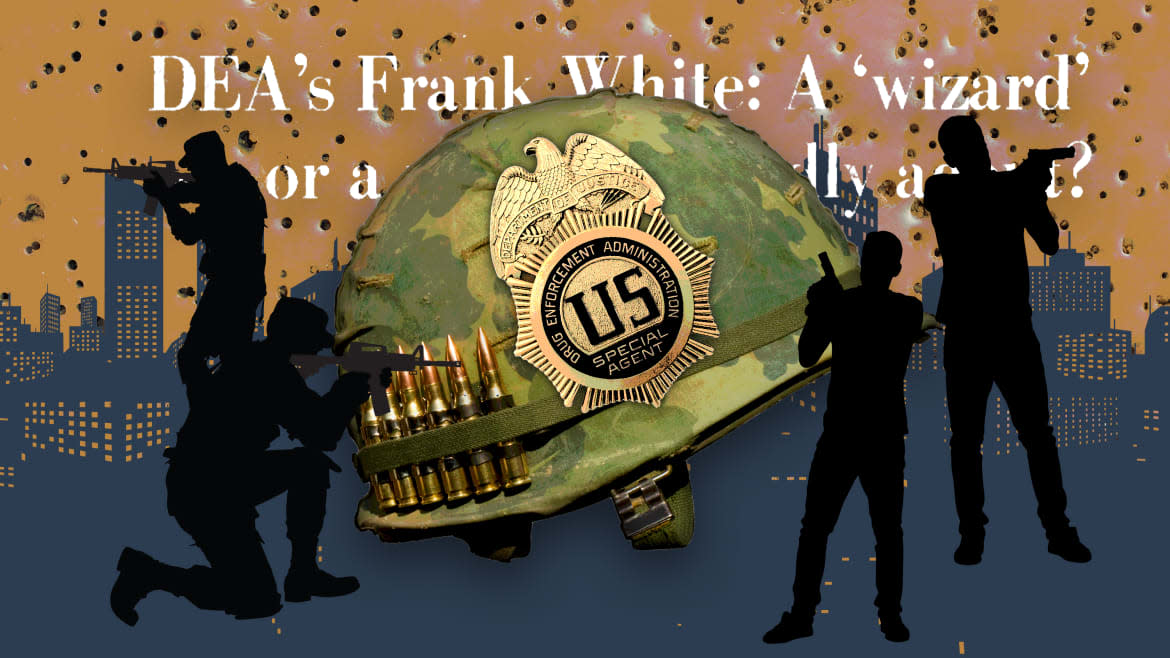
On the muggy summer night of July 31, 1980, the Drug Enforcement Administration (DEA) organized a sting operation at the Pompeii Warehouse south of Miami. Five undercover agents waited inside the warehouse with the drugs—15,000 pounds of marijuana in the back of a GM rental truck, which they planned to sell for $1 million cash.
Leading the sting was group supervisor Frank White, a 37-year-old Vietnam war hero. He and fellow agents were parked near the warehouse in unmarked sedans providing perimeter security.
At 9 p.m., a green Chevy with two antennas on the trunk pulled up to the warehouse and three men filed inside, carrying guns and police radios, and flashing police badges. “Police,” one of them yelled at the undercover agents. “You’re under arrest!”
The DEA agents, confused, lifted their hands. “I’m a DEA agent,” one said.
The gunmen searched the agents, took their guns, zip tied their hands, and forced them to lay face down on the concrete floor of the warehouse. The three gunmen weren’t really cops. It was a strange twist: drug dealers posing as lawmen, robbing lawmen posing as dealers.
The leader of the gunmen, a pudgy pot dealer named Walter Bostick, climbed into the marijuana-filled rental truck, as his colleagues lifted the overhead warehouse door. One of the DEA agents broke out of his cuffs, fired at the truck, and shouted over the radio, “It’s a rip-off!”
White flashed back to his partner, Frank Tummillo, killed in a rip-off in Times Square eight years earlier. President Nixon used the young agent’s death to rally support for his fledgling “war on drugs.” “We cannot bring Frank Tummillo back again any more than we can bring back the American soldiers who have given their lives in Vietnam,” President Nixon said in a radio address. Five months later, Nixon would escalate the war on drugs, launching the DEA.
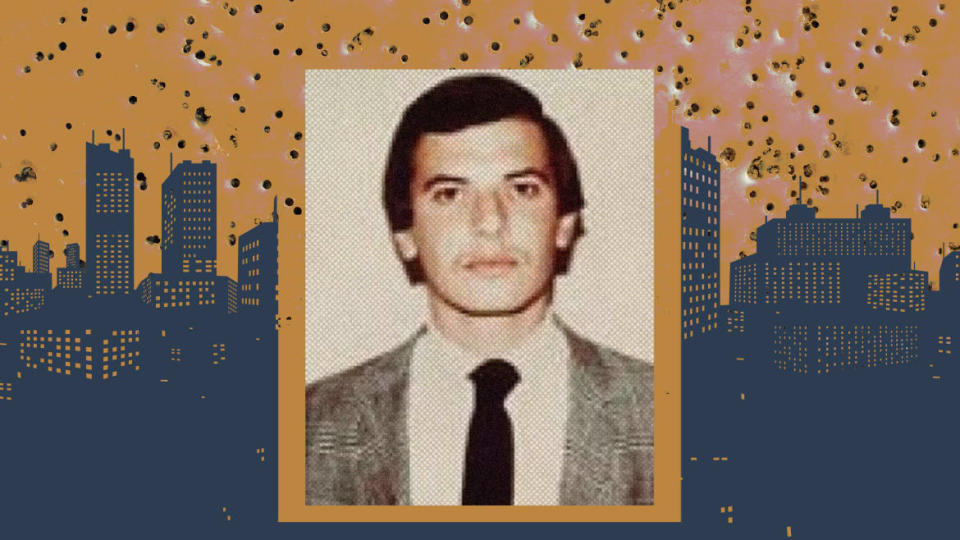
Frank White's partner, Special Agent Frank Tummillo.
White heard a burst from a DEA machine gun, shotgun blasts, then saw the rental truck ram through the partially closed warehouse gate, creating a shower of splinters. White, in his sedan, drove straight at the oncoming truck. He was moments from slamming into the heavier, narcotics-loaded vehicle, when the truck veered off the road and crashed into a ditch.
White jumped from his car and moved toward the rental truck’s passenger side. A fellow agent advanced toward the driver side. White spotted the driver—Bostick—lift a black Browning high power pistol. He yelled to the other agent, “Get down! Get down!”
The Stacks: A DEA Agent at War with the War on Drugs
Bostick heard him and aimed his pistol at White’s head. White gripped his 1911 pistol with two hands and fired seven rounds through the rental truck’s side window. Glass rained down, as White crouched next to the truck, checking his body for wounds and slamming a new clip into his pistol.
Bright muzzle flashes illuminated the night sky as White’s teammates emptied shotgun slugs and buckshot into the truck’s cab. Leaning against the truck, White could feel the bullets pound into the sheet metal. Figuring the driver was still a threat, White leaped onto the truck’s running board, grabbed the passenger door handle with his left hand, swung his pistol around with his right, and fired another clip at the dealer. Through the gun smoke, White saw the dealer’s body slumped over the steering wheel, with 32 bullet holes in him.
The Miami Herald called it a “Bonnie and Clyde” style massacre. “He had more bullet holes in him than if he’d run into a machine gun,” the Dade County medical examiner told the newspaper. White became the focus of a homicide investigation launched by the office of the local state attorney, Janet Reno. But when homicide investigators arrived at the warehouse, the DEA was cleaning up the evidence, without having photographed the scene. Agents testified Bostick had fired first, but it turned out he hadn’t fired a shot.
When asked in court why he’d shot the fleeing dealer nine times, White is said to have replied: “Nine? Because I ran out of bullets.”
Surviving two wars
When I reached out to the Association of Federal Narcotics Agents, asking about the Vietnam veterans who helped shape the early DEA, a contact immediately recommended Frank White. “I swear the first time I saw Frank walk into a room,” he told me, “I could hear the sound of a Huey’s rotor blades.”
I tracked down White just south of Chicago. He’d retired from the DEA three decades earlier, but continued his daily workouts and made regular visits to the Glen Park Izaak Walton pistol range, where he was known for his pinpoint accuracy (his Colt Combat Commander pistol, a gift from George H.W. Bush with ivory grips and engraved with White’s initials, FEW, is on display in the NRA Museum). He wrote a blog called “The White Report,” where he shared lessons in gun tactics, commented on police deadly force incidents, and advocated for better training of officers to reduce the danger to themselves and others during high stress encounters.
His voice surprised me: His thick New York accent and short nervous sentences combined to create a Woody Allen effect. But his philosophy and diction were that of a soldier. Instead of using my name in emails, he addressed me (in ALL CAPS) as “WARRIOR.” Instead of “OK,” he wrote, “10-4.” Instead of “keep me posted,” he wrote, “I’LL STAND IN THE DOOR AND AWAIT YOUR GREEN LIGHT.” Instead of “All the best,” he signed off with that old warrior’s promise: “SEMPER FI.”
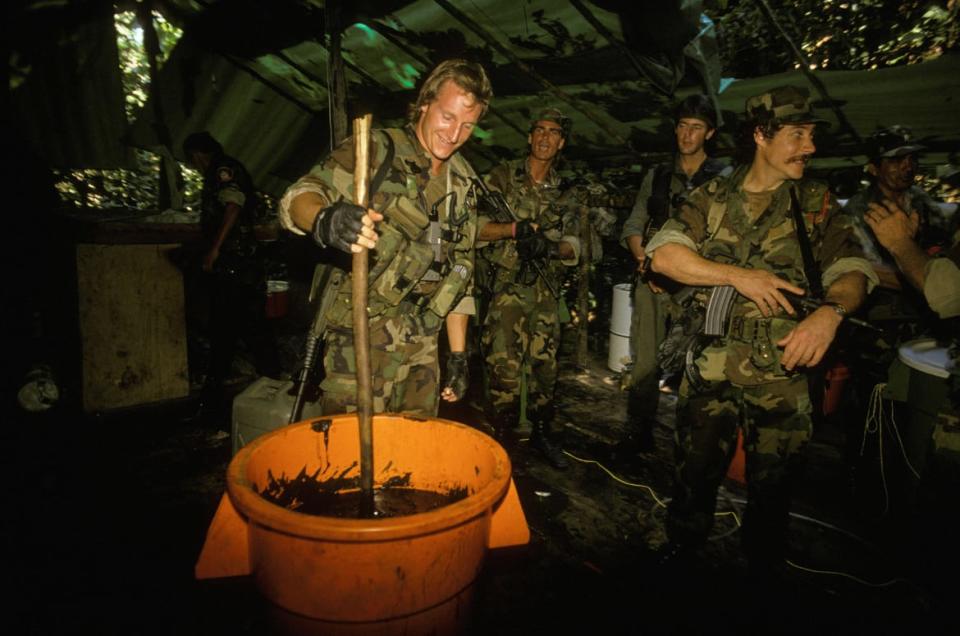
A DEA agent stirs cocaine paste in December 1989 during an operation in Peru.
“There is a direct translation of some of [Vietnam’s] battlefield tactics into law enforcement,” says Matthew Pembleton, author of the book Containing Addiction about the early years of the war on drugs. “You’ve got the same pilots who were flying helicopter missions in Vietnam buzzing marijuana fields in California’s Emerald Triangle in the 1970s.”
Around the DEA, they’re called the Jurassic Narcs: the hard-charging Vietnam veterans like White who formed the core of the early agency. They were sent to fight an un-winnable and unpopular war abroad, only to be recruited to fight the un-winnable war on drugs back in the U.S. The agents applied their Vietnam experience to dangerous undercover operations in drug-infested urban environments. “The tactics you learn in Vietnam,” White told me, “it’s often eyeball to eyeball. Up close. That’s what it’s like being an agent.”
With little in the way of an overarching strategy, the DEA adopted an uncomplicated approach: hunt the bad guys, cut off their suppliers, and seize contraband. If a sledgehammer is a blunt tool for solving a problem, the DEA’s first agents were wrecking balls. Motivated by a hatred of drugs and often tormented by wartime demons, these agents became crusaders, a ’70s and ’80s version of The Untouchables.
“I genuinely think it’s less about blood lust than the joy of the hunt and the thrill of the caper,” says Pembleton. “In depicting drugs as a terrible menace, they convinced themselves and everyone else that what they were doing—all the rules that they were breaking, and all the power that they were accruing—was absolutely necessary.”
They were agents like Billy Mockler, who in the 1980s tracked and busted a giant Medellín Cartel cocaine lab in the Colombian jungle; or Hector Berrellez, who kidnapped a Mexican doctor suspected of involvement in the murder of DEA agent Enrique “Kiki” Camarena; or Cellerino Castillo, who joined the agency because of his experience watching heroin kill a fellow GI. “His death scene gave me a purpose,” Castillo later wrote in his memoir. “If ever I left Vietnam, I would put all my energy into fighting America’s drug habit.”
From the outset, the DEA had a reputation as a rogue outfit among federal law-enforcement agencies. In 1977, according to The Washington Post, the Justice Department considered shutting the agency down, given concerns over its disregard for suspects’ civil rights, its focus on ineffective “street busts,” and its warlike tactics. Indeed, the 1970s saw a spike in violent drug busts, and the DEA was often involved in risky undercover stings, car chases, and daylight shootouts. Some argued that the aggressive approach was necessary because the organizations controlling the drug trade were becoming ever more sophisticated, powerful, and deadly. But to critics, the DEA’s penchant for violence was counterproductive.
The debate rages on, some 50 years later. The ACLU has warned about the excessive militarization of American policing, pointing to a classified DEA memo that “all but confirms the blurring of the lines between the drug war and the U.S. military.”
Criminal justice scholars agree. “The assumption is that if the cops are in a war on drugs… they’re being outgunned,” says Scott Phillips, a professor of criminal justice at Buffalo State College. “I’m old enough to remember when George H.W. Bush held up an Uzi [and] said this is the gun of choice of the drug dealers. I was a police officer in Houston in the mid-’80s, and I had a six-shot revolver, which was perfectly fine at the time, and perfectly fine now.”
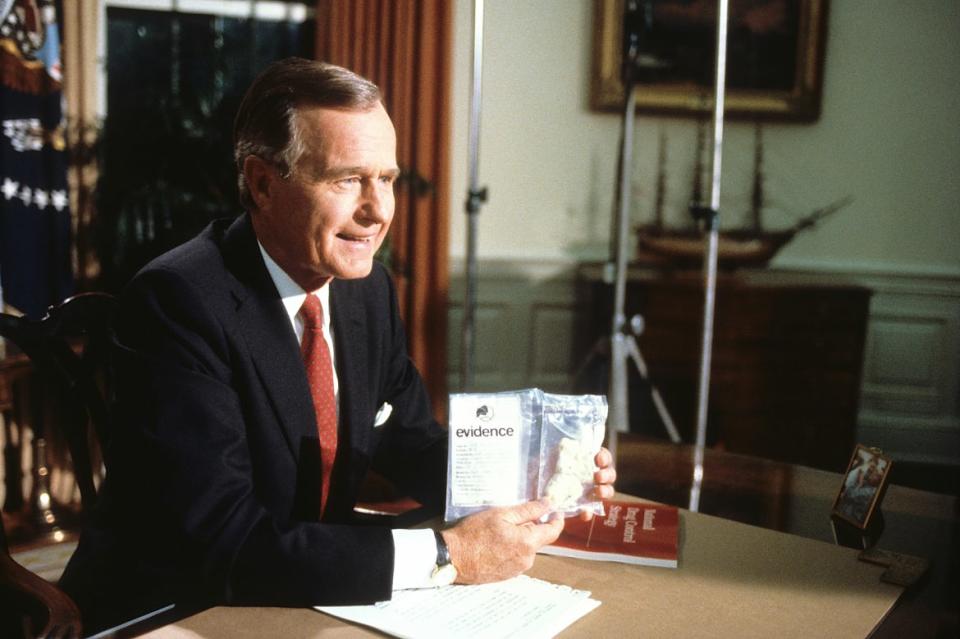
President George H.W. Bush holds up a bag of crack cocaine seized by DEA agents during his first address to the nation from the Oval Office in 1989.
Mirroring the heroin epidemic of the 1970s, the DEA’s new target is another opioid: fentanyl. Last year, the agency launched a 23-state initiative called Operation Overdrive to crack down on the powerful drug, conducting raids, making arrests, and seizing contraband.
The ACLU refers to these tactics as “stale and warmed-over war on drugs leftovers,” arguing that instead, “lawmakers should be laser-focused on rapidly scaling up evidence-based solutions that have proven effective at saving lives: overdose prevention centers, fentanyl test strips, safe supply, drug decriminalization, public education campaigns, and low-barrier access to naloxone and other rehabilitative and life-saving therapies.”
American voters, meanwhile, have lost confidence in the government’s approach to drug enforcement. Eighty-three percent of Democrats, 85 percent of Independents, and 82 percent of Republicans believe “the war on drugs has failed.”
Jeremy Kuzmarov, author of the book The Myth of the Addicted Army: Vietnam and the Modern War on Drugs, argues the premise of the war on drugs, like the war in Vietnam, was faulty from the outset. “Vietnam was a quagmire and the war on drugs is a quagmire,” he says. “People often live dreary lives and it’s human nature to seek intoxication of some kind. By fighting a war on drugs, you’re fighting a human impulse. So, the war on drugs will never succeed.”
White was a veteran of two failed wars, Vietnam and the war on drugs. But he remained proud of his service in both and considered the war on drugs a righteous one. “Part of it was continued service to your country,” White said. “It did feel something noble.”
Toy soldiers
The first time Frank White wanted to be a soldier was when he was 9 years old. Growing up in Manhattan, where his father owned a liquor store and his mother worked at Columbia University, he became friends with a middle-aged man who lived in the same apartment building. The man would often talk about his son, who’d been killed at the Battle of the Bulge near the end of World War II. The grieving father gave White his son’s old toy soldiers; and as White played with the little figurines on the carpeted floor of the quiet apartment, he’d listen to the man’s stories about his son, who’d won a Silver Star fighting the Germans. “If he could do it,” White thought, “I wanted to do it.”
He started training in high school, forgoing alcohol to keep his body clean, and waking up at 3:30 every morning for a three-hour workout. At 18, he enrolled at The Citadel, the state-run military college in South Carolina. The training was Spartan-like, with grueling physical conditioning and rampant hazing, all to instill discipline, humility, and mental fortitude in the cadets. White remembered, “The Citadel gave me a rich scholastic experience, a sense of order and a disciplined approach to life…”
Convicted DEA Agent Says He and Others Swindled the Government in ‘Very Fun’ Drug War
White counted himself lucky to graduate in 1965, just as the Vietnam War was heating up. He believed that America would lose in Vietnam, having studied the experience of the French, but that mattered less to him than putting his training to the test. “I was 22 years of age, I was a paratrooper, and I wanted to lead men in combat,” White recalled. On the flight to Vietnam, however, he worried about how he’d react under fire, whether he’d freeze up.
His first commander in Vietnam, whose actual name was Colonel Fear, sensed White’s apprehension and looked him hard in the eyes. “Soldiers may die as a result of your decisions, but if you fail to make a decision, I will court-martial you,” Fear growled. “Now get out and lead.”
Lieutenant White’s first crucible came on Thanksgiving, 1966, when his team of riflemen deployed in choppers to the Laotian border with orders to blow up a North Vietnamese base camp they thought was abandoned. Humping through the dense, triple-canopy jungle, a couple of hundred yards from the camp, White’s sergeant grabbed him by the sleeve. “They’re here,” he whispered. “They’re all around us.”
They crossed a gentle stream and were climbing the slope to the other side when the enemy opened fire. The battle lasted two days, with White’s team surrounded by about 200 enemy soldiers. On the second day, with his battered, shrinking team pinned down by a nearby machine gun, White climbed out of his foxhole and ran in a crouch toward the gun. The thick jungle made it difficult to see, but White had a good sense of the gun’s location, since it had killed several of his men. He arrived near the muzzle of the big belt-fed machine gun, where he watched a pair of enemy soldiers climb into a hole next to the weapon. He lifted his shotgun, leaned into the hole, and fired. He heard muffled screams under the ground, then more movement, so he reloaded the shotgun and kept firing until everyone in the hole was dead. (White was awarded a medal for his decisiveness and gallantry.)
Despite excelling as a frontline commander, White had no desire to become a career military man. After serving for a year in Vietnam, all of it spent in the jungle, he was debating what to do next when a Huey helicopter landed at his team’s jungle camp, flattening the tall grass with its propwash. There was a mailbag on board, with a letter from White’s father. The letter contained a newspaper clipping about a team of daring federal narcotics agents busting drug dealers in New York. White’s father—who knew his son’s appetite for adventure and derived a vicarious thrill—had written in the margin, “Take a look at this.”
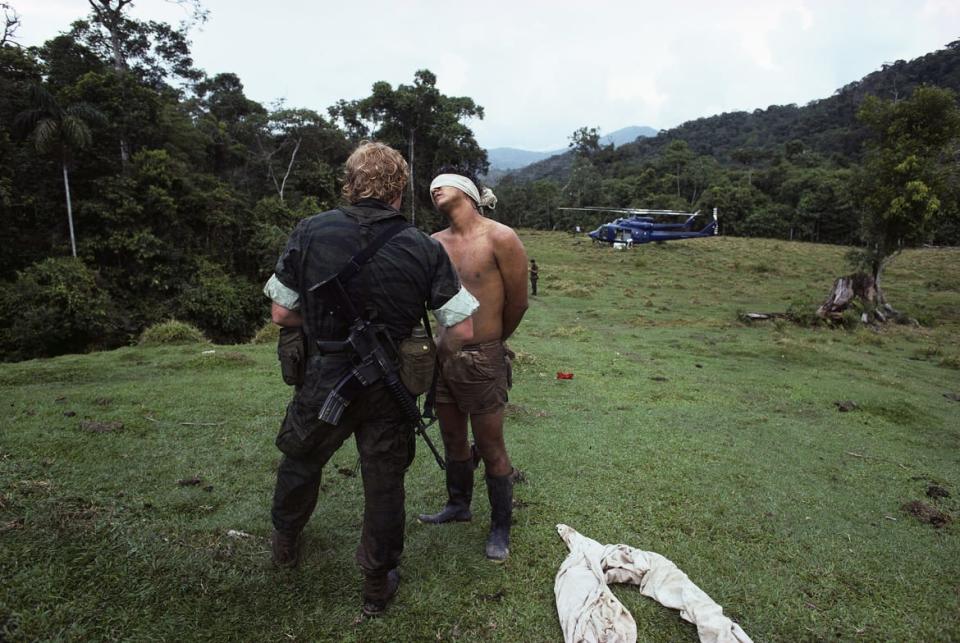
A DEA agent stands with a blindfolded prisoner following a raid on a cocaine lab in the Peruvian jungle.
In the street
Four years later, back home in Manhattan, White stalked through the darkness toward an idling Cadillac. It was boxed in, with White’s car parked in front of it, and several follow cars behind it. Gripping his .380 Walther PPK, White squinted through the windshield at the driver: Zack Robinson. A major heroin dealer, Robinson was an associate of Frank Lucas, the king of the Harlem heroin scene.
The city’s five boroughs were witnessing a surge in heroin addiction, murder and crime that summer, which would earn New York the nickname “Fear City.” The Bureau of Narcotics and Dangerous Drugs (BNDD) had been after Robinson for years. Now’s our chance, thought White.
White was approaching the Cadillac when it accelerated in reverse and crashed into one of the BNDD cars boxing it in. As metal crunched and glass showered, White spotted Robinson lift a long-barreled handgun above the steering wheel.
White fired through the windshield, the bullet piercing the glass and striking Robinson in the chest. Another agent fired through the Cadillac’s rolled-down driver’s window, hitting Robinson twice, then White fired six rapid shots into Robinson’s body.
Even with nine slugs in him, the former heavyweight boxer dragged himself across the center console and opened the passenger’s side door. Looking out, drenched in blood, Robinson saw White’s rookie partner, Frank Tummillo, pointing a revolver at him.
Far from a Vietnam hero, 24-year-old Tummillo joined the BNDD after 16 years of Catholic schools and still lived with his parents. The bloody Robinson staggered a few steps toward the young agent. Tummillo lowered his gun, then Robinson collapsed. (Remarkably, despite being shot nine times, Robinson survived the assault).
The New York City narcs worked on the 14th floor of 90 Church St., a squat, blocky building that shared offices with the Post Office, the IRS, and the Treasury Department, which back in Prohibition days had held the mandate to root out smugglers and bootleggers. As a rookie agent, White had trained under World War II veterans—“kick-ass guys,” he remembered—and worked alongside the agents who severed the French Connection. Most of the men in White’s group were military veterans: a captain in military intelligence who’d served in Vietnam, an Air Force radar captain, and a lieutenant in the Coast Guard. Supervising the office was Jim Hunt, an Army veteran like White who’d been wounded in the legs by a German machine gun in World War II.
Just as in Vietnam, where hawks called for the government to “take the handcuffs off” the soldiers and let them win the war, many agents in White’s group deplored judges who were soft on crime, nicknaming them “Weak Annies.” One agent told The New York Times, “Do you know what it’s like to risk your life on a job and then see a guy walk?” The agent said he’d voted for President Nixon—“to get rid of most of the Weak Annies in the courts.”
Tummillo represented a more restrained model of drug enforcement, as when he’d lowered his pistol during the Robinson shootout. “He was unique as an agent,” White would recall. “Quiet, considerate. Most people are more boisterous, loud, more cop‐type, aggressive.” White added, “Everybody had dignity, to [Tummillo]. Many times he said he was sorry for [the dealers], they’d grown up in ghetto conditions, where the only people they could look up to were peddlers driving their Cadillacs. He’d say it was too bad they didn’t have the strength of family he had.”
Tummillo’s empathy and good nature made him a natural for undercover work, winning him the affection and trust of even the most hardened drug traffickers. A rising star within the agency, his pay shot up from $12,000 to $19,000 and he even got to meet President Nixon in a bureau event at the White House. Team members often borrowed him to conduct undercover busts, exposing him to longer hours and more danger.
At 10 p.m. on October 12, 1972, White was at his desk, clacking out a report on his typewriter, when he got the call that his partner, Tummillo, had been gunned down by a suspected drug smuggler and was in critical condition at a local hospital.
Tummillo had been conducting an undercover buy-bust at the Sheraton Midtown Motor Inn, a seedy Times Square hotel favored by pimps and drug dealers. Tummillo showed the two traffickers the money, and they said they’d come back with the drugs. Instead, they came back with guns drawn—a “rip-off.”
White sped to the hospital in his sedan, his mind swirling. Earlier that day, Tummillo had told White that he was nervous about the operation and planned to back out. The young agent was less experienced with a gun than combat-savvy White. Set to marry his high school sweetheart in a couple months, Tummillo had confessed to White that he might not be cut out for the dangerous work of an undercover narc. White had promised his young partner that whenever a shootout went down, he’d have his back. But a different group of agents had organized the Sheraton operation, so White hadn’t been there to fulfill his promise.
Arriving at the hospital, White was directed to the emergency trauma center. It was quiet inside as he walked alone to the steel table in the middle of the room. There lay a body bag. White pulled up the zipper slowly and looked down on the lifeless face of his partner. Tummillo had a thin mustache, wispier than White’s fuller one. His expression was blank, and the two bullet holes in his chest were dark. Tummillo was gone.
Guilt boiled inside Frank White. And anger.
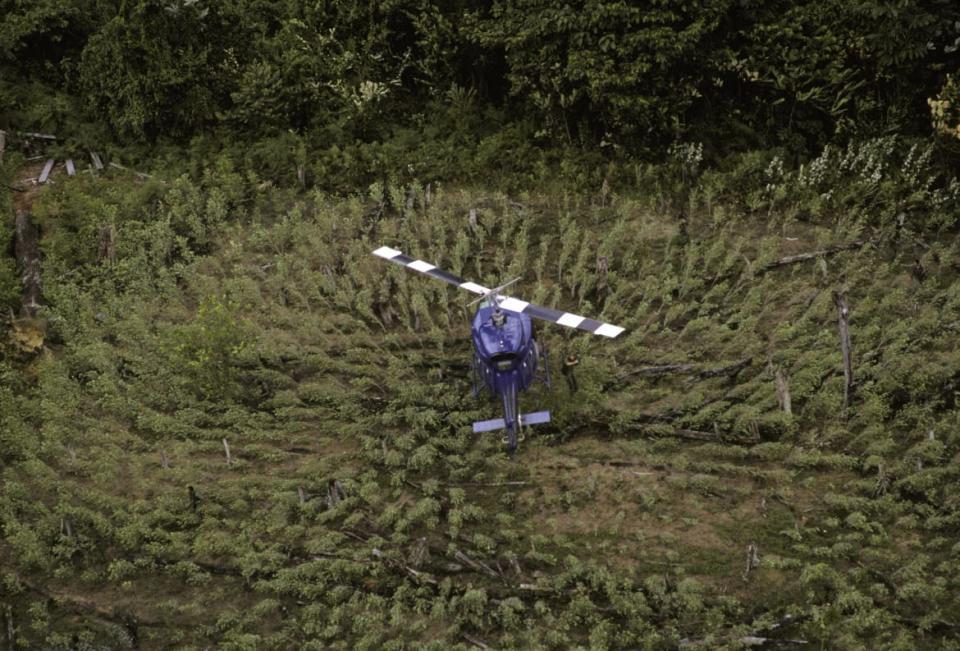
DEA agents and Peruvian special anti-narcotics police attack and destroy cocaine paste processing plants in the Huallagua valley from a base in Tingo Maria, Peru.
Family man
Immediately after Tummillo’s death, White was put in charge of a DEA group. He recruited agents like him and Tummillo: hard-working, self-motivated, willing to take risks and make busts. “I had a motto,” White said: “Be good or be gone.”
White’s responsibilities also expanded on the home front when he and his wife decided to adopt a child. White had the idea to adopt from Vietnam, given his connection to the country and the fact so many children were being killed in the war. The couple went through the lengthy adoption process. Finally, a child services adviser informed them who their son would be: a young boy in an orphanage outside Saigon. The boy’s parents had been killed in the fighting, and he’d suffered a shrapnel wound to the neck that destroyed part of his hearing. White contacted a fellow narcotics agent in Vietnam and shipped over some toys to deliver to the boy’s orphanage: building blocks, toy trucks, a baseball bat and glove. Soon after, the boy was on a plane to New York’s La Guardia Airport, where he met his new parents.
White’s son was his last connection to Vietnam. He didn’t keep up with any fellow veterans—“the ones that I got close with all died,” he said—and he’d avoided taking pictures. “I was hesitant because I didn’t want pictures of people I knew that was going to get killed; and also I figured I was going to get killed. So I just lived that day… I just stayed away from pictures, memories.” It is a symptom of PTSD—dodging distressing feelings, thoughts, and memories—and yet White told me he never believed in PTSD. “People that get it, they break along a fissure that’s already there before the fight,” he argued. “Combat never affected me.”
After eight years leading DEA groups in New York, White was told by his supervisor that his tactical expertise was needed elsewhere. Cocaine was flooding into South Florida, triggering a spike in violence and murders. “We’re sending you to Miami,” White’s supervisor said.
Following his shootout at Miami’s Pompeii warehouse, newspaper reporters grappled with whether White’s actions had been reckless, or necessary. “Depending on whom you talk to,” reporter Carl Hiaasen wrote for The Miami Herald, “Francis White is either a trigger-happy renegade, or one of the Drug Enforcement Administration’s elite super-agents.”
When agents in White’s group spoke to the media, they routinely praised him for his skill, leadership, and instinct. “Frank is an agent’s agent, always first through the door,” one team member would later recall. “His body hums when he’s on the street. He knows what’s going on, he knows his prey and when to anticipate trouble.”
Agents appreciated White’s steady hand during gun fights, which can wreak havoc on the nerves of the uninitiated. One of the agents handcuffed in the warehouse told a reporter that he went home and “screamed, cried, and cursed until I got it out of my system.” He added: “If you don’t, you’re liable to get aggressive or paranoid and hurt someone.” Another Miami DEA agent told a reporter, “Do you know what the adrenaline is like when you pull a gun on somebody? After it’s over, your heart is pounding… That night you can’t sleep, your muscles twitch while you’re lying in bed.”
But others argued White’s tactics had no place in a civilized democracy. Roy Kahn, an assistant state attorney under Janet Reno, lambasted White in the press, calling him negligent and out-of-control. “The man should not be in the position he’s in,” Kahn told The Miami Herald.
Despite the scrutiny, White refused to alter his tactics. A year after the warehouse operation, his squad tracked drug fugitive Miguel Miranda to a restaurant in South Miami. Miranda—one of the city’s infamous “Cocaine Cowboys”—tried to escape in his car, ramming into other vehicles then crashing into a wall. For at least one of White’s team members, it was a predictable scenario: “Things always seemed to gravitate toward us, especially when Frank was around,” he’d recall.
White leaped from his vehicle, fired from behind Miranda’s car and hit him twice in the head. The DEA conducted an internal probe, and Reno’s office launched a second homicide investigation. “It was known that Janet Reno… wanted to charge him,” a state attorney would recall.
White, in a Miami Herald interview, defended his actions: “I have no badge of shame about what happened… How do you arrest a guy like that?” In a search of Miranda’s compound, DEA agents found machine guns, shotguns, and pistols; a silencer-equipped .22 linked to 10 dead bodies found around Miami; jars of cocaine and other drugs; bullet holes in the walls; a sex room equipped with handcuffs, chains, and an examination table; and a backyard animal sacrifice altar. “A bunker Hitler would have been proud of,” White told the newspapers.
White was cleared in both homicide probes and the DEA investigation. In 1984, Vice President George H.W. Bush appointed him to lead the Joint Task Force on Drugs, which came with a desk job in D.C. It was an honor, but White loathed putting on a suit and sitting in an office. His mindset remained that of a street agent, even in his choice of office décor: He kept two submachine guns against the wall with boxes of extra ammo stacked nearby. On one occasion, when a visitor asked about the high-caliber weapons, White replied: “I survived Vietnam and if the Colombians storm this place, I will be ready.”
Around that time, in the mid-’80s, White’s marriage fell apart. He and his wife divorced, and their son stayed with his wife.
In 1988, White was summoned for one last mission, an elite clandestine operation in Peru called Operation Snowcap. The objective was to seek out and destroy cocaine laboratories on the drug lords’ home turf. Riding in a Huey helicopter over the dense Peruvian jungle, armed with a machine gun, ammo clips, and fragmentation grenades, White felt like he was back in the Central Highlands of South Vietnam, back where he belonged.
Two years later, he grudgingly left Peru and was transferred to the DEA’s Chicago field office. There, as Associate Special Agent in Charge, he openly criticized President Bill Clinton and Attorney General Janet Reno for what he saw as their lack of resolve in the war on drugs.
By the mid-’90s, most of the Jurassic Narcs had retired or had been pushed out, as the DEA shifted from the “kick down the door” tactics of its early days to an emphasis on technology and wiretaps. White drew frequent criticism for his anachronistic attitude and militaristic approach to drug enforcement, and in 1995, he was pressured to retire.
He was 52 years old at the time and couldn’t envision how he’d spend the rest of his life, stripped of his purpose waging the war on drugs, stripped of his lifelong identity as a soldier. Boxing up his office, White flashed on that melancholy line from General Douglas MacArthur’s farewell speech at West Point: “Old soldiers never die, they just fade away.”
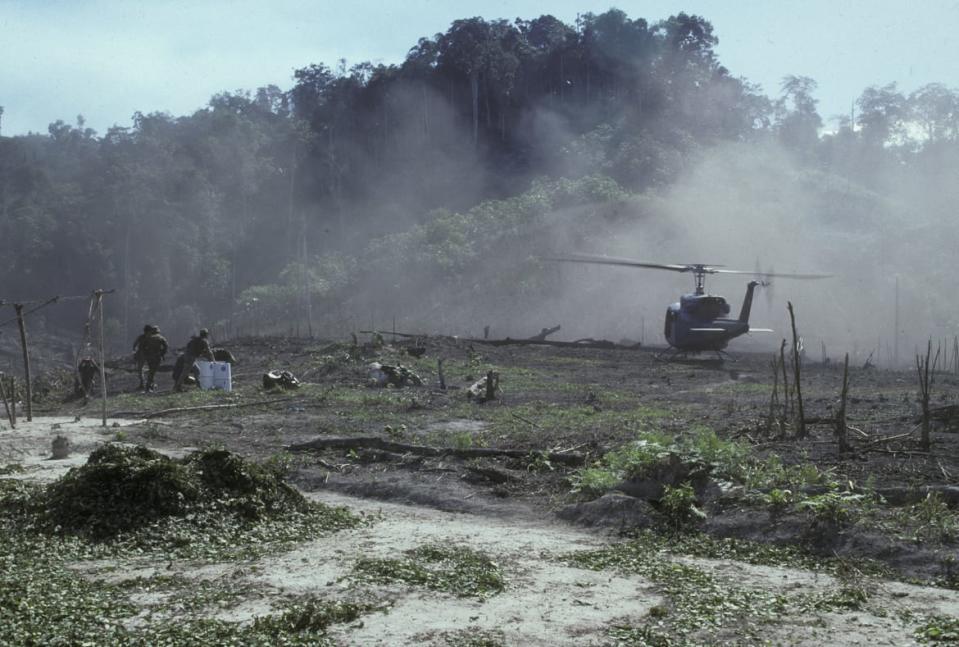
Specially trained U.S. Drug Enforcement agents and Peruvian special anti-narcotics police attack and destroy cocaine paste processing plants in the Huallagua Valley from a base in Tingo Maria, Peru in the 1980s.
The rifleman
Had White fought in the days of MacArthur, his warrior spirit may have been celebrated. But as the veteran of two controversial, failed wars, there were no newspaper obituaries to mark his passing on Dec. 15, 2022. Tributes did, however, pour in on White’s online memorial page. Without exception, the commenters celebrated him for his bravery, leadership, and patriotism.
“One of a kind,” wrote George Whelan. “Made decisions, stuck by them and supported his subordinates to the hilt. Saved my butt more than once and never brought it up. Controversial for sure but effective. Did whatever he instructed subordinates to do.”
“I always looked up to him,” wrote Brian Chobot. “From Frank I learned the meaning of my love for my country, my love for the US Army and my career in law enforcement.”
“May his memory not fade away,” wrote Guadalupe Sanchez. “A true leader and warrior in his time.”
His body was interred at his old college, The Citadel. I visited the school in late May, around Memorial Day. It sits on the outskirts of Charleston, where Spanish moss hangs low over cobblestone streets lined with old antebellum homes, and out on the harbor, a giant American flag flutters over Fort Sumter, where the first shots of the Civil War were fired. With the Citadel’s student body on summer furlough, there were no recruits marching in formation or spilling out of the school buildings, built to resemble a castle’s tower and fortifications. Sprinkled around the wide grassy parade grounds, on display, were a pair of gold cannons, a World War II Sherman tank, and a Vietnam-era F4 Phantom fighter jet. In the eerily empty school, the old artifacts of war reminded me of dinosaur skeletons at a natural history museum, awe-inspiring in their time, now relics of the past.
White’s ashes are housed inside the belltower of the Citadel's old church, Summerall Chapel. In front of the belltower stands a plaque of dark granite, engraved with the words: “Duty Done, they rest, so we may live free.”
I entered the belltower alone and searched its four walls for the vault containing White’s ashes. His simple bronze nameplate was difficult to find among the rows of identical nameplates. Knowing White’s story, I felt he deserved more fanfare—a short writeup perhaps, or at least flowers or a flag. Then again, he never aspired to fanfare, to high rank or fancy titles. Of his many nicknames—“Dirty Harry” and “The Wizard” among them—he told me his favorite was “The Rifleman,” because that’s how he saw himself: as a humble rifleman. And there, in the dimly lit crypt at the Citadel, scanning the names of other warriors past, I decided this was the perfect resting place for Frank White, the Rifleman. He was with his men.
Andrew Dubbins is an award-winning journalist and author of Into Enemy Waters: A World War II Story of the Demolition Divers Who Became the Navy SEALs. His Alta Journal story, “When the Mafia Came to Lodi,” is in development as an Amazon series starring Ewan McGregor. His Daily Beast story, “Snow Fall,” is in development as a feature film. His work has appeared in The Los Angeles Times, Smithsonian, Men’s Health, and other publications.
Get the Daily Beast's biggest scoops and scandals delivered right to your inbox. Sign up now.
Stay informed and gain unlimited access to the Daily Beast's unmatched reporting. Subscribe now.

